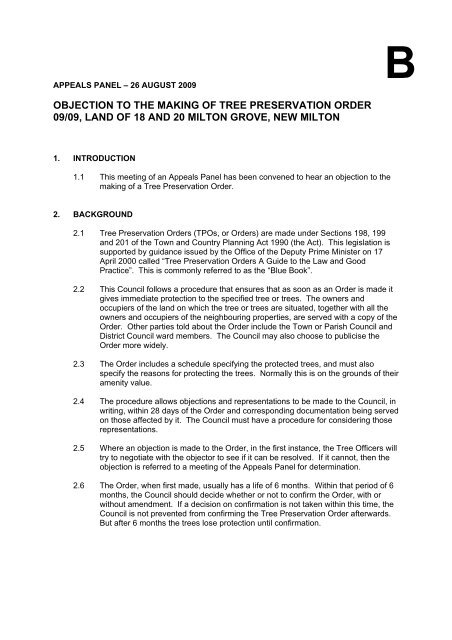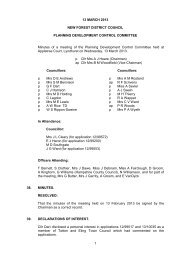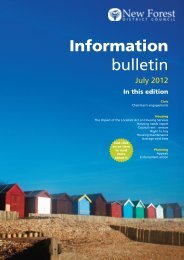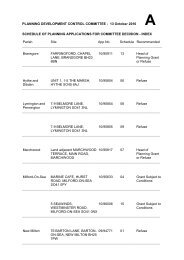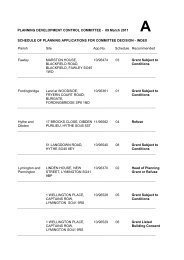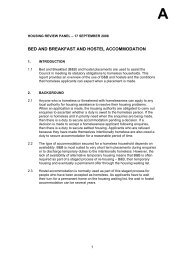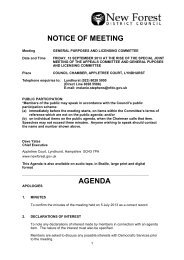Tree Preservation Order No. 09/09 - New Forest District Council
Tree Preservation Order No. 09/09 - New Forest District Council
Tree Preservation Order No. 09/09 - New Forest District Council
You also want an ePaper? Increase the reach of your titles
YUMPU automatically turns print PDFs into web optimized ePapers that Google loves.
APPEALS PANEL – 26 AUGUST 20<strong>09</strong>BOBJECTION TO THE MAKING OF TREE PRESERVATION ORDER<strong>09</strong>/<strong>09</strong>, LAND OF 18 AND 20 MILTON GROVE, NEW MILTON1. INTRODUCTION1.1 This meeting of an Appeals Panel has been convened to hear an objection to themaking of a <strong>Tree</strong> <strong>Preservation</strong> <strong>Order</strong>.2. BACKGROUND2.1 <strong>Tree</strong> <strong>Preservation</strong> <strong>Order</strong>s (TPOs, or <strong>Order</strong>s) are made under Sections 198, 199and 201 of the Town and Country Planning Act 1990 (the Act). This legislation issupported by guidance issued by the Office of the Deputy Prime Minister on 17April 2000 called “<strong>Tree</strong> <strong>Preservation</strong> <strong>Order</strong>s A Guide to the Law and GoodPractice”. This is commonly referred to as the “Blue Book”.2.2 This <strong>Council</strong> follows a procedure that ensures that as soon as an <strong>Order</strong> is made itgives immediate protection to the specified tree or trees. The owners andoccupiers of the land on which the tree or trees are situated, together with all theowners and occupiers of the neighbouring properties, are served with a copy of the<strong>Order</strong>. Other parties told about the <strong>Order</strong> include the Town or Parish <strong>Council</strong> and<strong>District</strong> <strong>Council</strong> ward members. The <strong>Council</strong> may also choose to publicise the<strong>Order</strong> more widely.2.3 The <strong>Order</strong> includes a schedule specifying the protected trees, and must alsospecify the reasons for protecting the trees. <strong>No</strong>rmally this is on the grounds of theiramenity value.2.4 The procedure allows objections and representations to be made to the <strong>Council</strong>, inwriting, within 28 days of the <strong>Order</strong> and corresponding documentation being servedon those affected by it. The <strong>Council</strong> must have a procedure for considering thoserepresentations.2.5 Where an objection is made to the <strong>Order</strong>, in the first instance, the <strong>Tree</strong> Officers willtry to negotiate with the objector to see if it can be resolved. If it cannot, then theobjection is referred to a meeting of the Appeals Panel for determination.2.6 The <strong>Order</strong>, when first made, usually has a life of 6 months. Within that period of 6months, the <strong>Council</strong> should decide whether or not to confirm the <strong>Order</strong>, with orwithout amendment. If a decision on confirmation is not taken within this time, the<strong>Council</strong> is not prevented from confirming the <strong>Tree</strong> <strong>Preservation</strong> <strong>Order</strong> afterwards.But after 6 months the trees lose protection until confirmation.
3. CRITERIA FOR MAKING A TREE PRESERVATION ORDER3.1 A local planning authority may make an <strong>Order</strong> if it appears to them to be:“expedient in the interests of amenity to make provision for the preservation oftrees or woodlands in their area”.4. TYPES OF TREE PRESERVATION ORDER4.1 The <strong>Tree</strong> <strong>Preservation</strong> <strong>Order</strong> may specify one or more individual trees, groups oftrees, woodlands or, more rarely, refer to an area of land.4.2 As a general rule, an individually specified tree must meet the criteria for protectionin its own right.4.3 A group of trees must have amenity value as a group, without each individual treenecessarily being of outstanding value. The value of the group as a whole may begreater than that of the individual trees.4.4 A woodland order would be imposed over a more significant area of trees, where itis not practical, or indeed perhaps even desirable, to survey or specify individualtrees or groups of trees. While each tree is protected, not every tree has to havehigh amenity value in its own right. It is the general character of the woodland thatis important. In general terms a woodland will be a significant area of trees, thatwill not be interspersed with buildings.4.5 An area designation covers all the trees, of whatever species, within a designatedarea of land, and these may well be interspersed among a number of domesticcurtilages and around buildings. An area order may well be introduced, as aholding measure, until a proper survey can be done. It is normally consideredgood practice to review area orders and replace them with one or more orders thatspecify individuals or groups of trees. This process has been underway in this<strong>District</strong>, with the review of a number of older area orders that were imposed someyears ago in response to proposed significant development. An area order is alegitimate tool for the protection of trees. It is not grounds for an objection that theorder is an area order.5. THE ROLE OF THE PANEL5.1 While objectors may object on any grounds, the decision about confirmation of the<strong>Order</strong> should be confined to the test set out in 3.1 above.5.2 The Secretary of State advises that it would be inappropriate to make a TPO inrespect of a tree which is dead, dying or dangerous.5.3 Amenity valueThis term is not defined in the Act, but there is guidance in the Blue Book. Insummary the guidance advises:
• TPOs should be used to protect selected trees and woodlands if their removalwould have a significant impact on the local environment and its enjoyment bythe public.• There must be a reasonable degree of public benefit. The trees, or part ofthem, should therefore normally be visible from a public place, such as a roador a footpath. Other trees may however also be included, if there isjustification.• The benefit may be present or future.• The value of the tree or trees may be from their intrinsic beauty; for theircontribution to the landscape; or the role they play in hiding an eyesore orfuture development.• The value of trees may be enhanced if they are scarce.• Other factors, such as their importance as a wildlife habitat, may be taken intoaccount, but would not, alone, be sufficient to justify a TPO.As a general rule, officers will only consider protecting a tree where they aresatisfied that it has a safe life expectancy in excess of 10 years.5.4 ExpediencyAgain, this is not defined in the Act, but some guidance is given in the Blue Book.In essence, the guidance says:• It is not expedient to make a TPO in respect of trees which are under goodarboricultural or silvicultural management.• It may be expedient to make a TPO if the local authority believes there is a riskof the trees being cut down or pruned in ways which would have a significantimpact on the amenity of the area. It is not necessary for the risk to beimmediate. It may be a general risk from development pressures.• A precautionary TPO may also be considered appropriate to protect selectedtrees in advance, as it is not always possible to know about changes inproperty ownership and intentions to fell.6. THE EFFECT OF THE ORDER6.1 Once the TPO has been made, it is an offence to do any works to the protectedtree or trees without first gaining consent from the <strong>Council</strong> through a tree workapplication unless such works are covered by an exemption within the Act. In thisrespect of the Local Planning Authority consent is not required for cutting down orcarrying out works on trees which are dead, dying or dangerous, or so far as maybe necessary to prevent or abate a nuisance. Great care should be exercised byindividuals seeking to take advantage of an exemption because if it is wronglymisjudged offences may be committed. There is no fee charged for making a <strong>Tree</strong>Work Application.6.2 If consent is refused, the applicant has the right of appeal to the Secretary of State.
7. CONSIDERATION7.1 Members are requested to form a view, based on the evidence before them,whether it appears to them to be expedient in the interests of amenity to confirmthe TPO taking into account the above guidance. Members will have visited thesite immediately prior to the formal hearing, to allow them to acquaint themselveswith the characteristics of the tree or trees within the context of the surroundinglandscape.7.2 The written evidence that is attached to this report is as follows:Appendix 1Appendix 2Appendix 3Appendix 4The schedule and map from the <strong>Order</strong>, which specifies all thetrees protected.The report of the <strong>Council</strong>’s <strong>Tree</strong> Officer, setting out all the issueshe considers should be taken into account, and making the casefor confirming the <strong>Order</strong>.Development Control consultation on ENQ/<strong>09</strong>/15737The written representations from the objectors to the making ofthe <strong>Order</strong>.Members will hear oral evidence at the hearing, in support of these writtenrepresentations. The procedure to be followed at the hearing is attached to theagenda.8. FINANCIAL IMPLICATIONS8.1 There are some modest administrative costs associated with the actual process ofserving and confirming the TPO. There are more significant costs associated withthe need to respond to any <strong>Tree</strong> Work Applications to do works (lopping, topping orfelling) see 8.3 below. The officers will normally visit the site and give advice onpotential works to the trees.8.2 The <strong>Council</strong> does not become liable for any of the costs of maintaining the tree ortrees. That remains the responsibility of the trees’ owners.8.3 TPOs make provision for the payment by the Local Planning Authority ofcompensation for loss or damage caused or incurred as a result of:(1) their refusal of any consent under the TPO, or(2) their grant of a consent subject to conditions.To ascertain whether someone is entitled to compensation in any particular case itis necessary to refer to the TPO in question. It is especially important to note thatthe compensation provisions of TPOs made on or after 2 August 1999 differsubstantially from the compensation provisions of TPOs made before that date.
TPOs made before 2 August 1999Under the terms of a TPO made before 2 August 1999 anyone who suffers loss ordamage is entitled to claim compensation unless an article 5 certificate has beenissued by the Local Planning Authority.TPOs made on or after 2 August 1999In deciding an application for consent under a TPO made on or after 2 August1999 the Local Planning Authority cannot issue an article 5 certificate. There is ageneral right to compensation. However, the TPO includes provisions which areintended to limit the Local Planning Authority's liability to a fair and reasonableextent, and so the general right to compensation is subject to the followingexceptions:(1) no claim for compensation can be made if the loss or damage incurredamounts to less than £500;(2) no compensation is payable for loss of development value or other diminutionin the value of the land. ‘Development Value’ means an increase in valueattributed to the prospect of developing land, including clearing it;(3) no compensation is payable for loss or damage which, bearing in mind thereasons given for the application for consent (and any documents submittedin support of those reasons), was not reasonably foreseeable when theapplication was decided;(4) no compensation is payable to a person for loss or damage which was (i)reasonably foreseeable by that person, and (ii) attributable to that person’sfailure to take reasonable steps to avert the loss or damage or mitigate itsextent; and(5) no compensation is payable for costs incurred in bringing an appeal to theSecretary of State against the Local Planning Authority’s decision to refuseconsent or grant it subject to conditions.9. ENVIRONMENTAL IMPLICATIONS9.1 The trees must have significant value within their landscape to justify theconfirmation of the TPO.10. CRIME AND DISORDER IMPLICATIONS10.1 There are no crime and disorder implications arising from this report.11. OTHER IMPLICATIONS11.1 The making or confirmation of a <strong>Tree</strong> <strong>Preservation</strong> <strong>Order</strong> could interfere with theright of the property owner peacefully to enjoy his possessions but it is capable ofjustification under Article 1 of the First Protocol as being in the public interest (theamenity value of the tree).
11.2 In so far as the trees are on or serve private residential property the making orconfirmation of a <strong>Tree</strong> <strong>Preservation</strong> <strong>Order</strong> could interfere with the right of a personto respect for his family life and his home but is capable of justification as being inaccordance with the law and necessary in a democratic society for the protection ofthe rights and freedoms of others (Article 8).12. RECOMMENDED:12.1 That the Panel consider all the evidence before them and determine whether toconfirm <strong>Tree</strong> <strong>Preservation</strong> <strong>Order</strong> <strong>09</strong>/<strong>09</strong> relating to land of 18 and 20 Milton Grove,<strong>New</strong> Milton with, or without, amendment.For Further Information Please Contact:Jan DebnamCommittee AdministratorTel: (023) 8028 5389E-mail: jan.debnam@nfdc.gov.ukBackground Papers:Attached Documents:TPO <strong>09</strong>/<strong>09</strong>Published documentsGrainne O’RourkeHead of Legal and Democratic Services.Tel: (023) 8028 5285E-mail: grainne.orourke@nfdc.gov.uk
APPENDIX 2OBJECTION TO TREE PRESERVATION ORDER NO. <strong>09</strong>/<strong>09</strong>LAND OF 18 AND 20 MILTON GROVE, NEW MILTON, HANTSREPORT OF COUNCIL’S TREE OFFICER1 TREE PRESERVATION ORDER HISTORY1.1 <strong>Tree</strong> <strong>Preservation</strong> <strong>Order</strong> (TPO) <strong>09</strong>/<strong>09</strong> was made on 18 March 20<strong>09</strong>.The TPO plan and first schedule are attached as Appendix 1 to ReportB. The <strong>Order</strong> protects two individual trees, T1 a Monterey Cypresssituated adjacent to the eastern boundary of 18 Milton Grove, and T2an Ash situated adjacent to northern boundary of 18 Milton Grove,<strong>New</strong> Milton, Hants1.2 The TPO was made as a result of the submission of a planningenquiry (Ref: ENQ/<strong>09</strong>/15737) to erect a detached bungalow in thegrounds of 18 Milton Grove. Comments made on this planning enquirycan be found in Appendix 3 to Report B.1.3 While assessing the planning enquiry the <strong>Council</strong>’s <strong>Tree</strong> Officerdecided that, due to the condition of the tree and the potential for redevelopmentof 18 Milton Grove, the Monterey Cypress should beprotected as a precautionary measure against its removal orinappropriate trimming. The Ash tree was also included due to itslocation within 20 Milton Grove. At the time of the visit anothersubstantial Cedar tree located along the shared boundary with 18 wasin the process of being dismantled. The trees are clearly visible to thepublic and make a positive contribution to the landscape of theimmediate and surrounding area. It is considered that their potentialpremature loss would be of detriment to the area. As such it wasconsidered to be expedient to protect the trees through a TPO.1.4 Three letters objecting to the making of the TPO have been receivedfrom Mrs Fisher of 17 Hale Avenue, Mr Elliott of 19 Hale Avenue andMr Tyler of 20 Milton Grove, <strong>New</strong> Milton.1.5 The <strong>Council</strong>’s Senior <strong>Tree</strong> Officer met with Mrs Fisher and Mr and MrsElliott on site (02.07.20<strong>09</strong>) and discussed the objections raised to themaking of the <strong>Order</strong>.2 THE TREES2.1 The trees in question are a mature Monterey Cypress situatedadjacent to the eastern boundary of 18 Milton Grove and an Ashsituated adjacent to northern boundary of 18 Milton Grove, <strong>New</strong>Milton, Hants2.2 From a ground level inspection the trees are in a generally goodcondition. The Monterey Cypress has not been managed for some
considerable time and would benefit from some tree surgery workbeing undertaken. Suitable works would include crown cleaning, ivybanding and the reduction of over extended branch ends. The Ashtree is exhibiting no major defects that would necessitate therequirement for a further inspection or question the tree’s safety.2.3 The trees offer a good/high level of visual amenity to the immediateand surrounding areas and can be clearly seen by the public fromvantage points. The trees are particularly prominent from MiltonGrove, Hale Avenue and Waverley Road.3 THE OBJECTIONCopies of the objection letters are included as Appendix 4 of Report B.The grounds for objection to the Monterey Cypress are:• The Monterey Cypress (Macrocarpa) is unsafe and vulnerable to high windsand is top heavy.• The tree is unsuitable for a residential area and does not contribute to thesurrounding landscape in a positive way.• The shade created by the tree (Monterey Cypress) hinders growth in nearbygardens• TPO’s should only be made on trees in suitable locations• <strong>Tree</strong> roots are damaging the adjacent house (18 Milton Grove)The grounds for objecting to the Ash are:• The TPO will stop the tree from being maintained• I will not be able to grow fruit and vegetables as I wish, the TPO poses anarboreal infringement• Will the <strong>Council</strong> take responsibility for damages to the greenhouse or for thetree should it fail?4 OBSERVATIONS ON THE GROUNDS OF OBJECTIONThe Monterey Cypress4.1 Since the <strong>Order</strong> was originally made the tree has been closelyinspected and while the tree is not in perfect condition, with suitablemanagement its condition can be simply and successfully addressed.The TPO does not prevent suitable tree works being carried out.However the submission of a <strong>Tree</strong> Works Application, which incurs nocost, would be required and consent granted before any works can beundertaken.4.2 As will be noted when the site visit is undertaken, it is not unusual tofind Monterey Cypress in residential gardens. There is a similar treelocated within the rear of the house opposite, 10 Hale Avenue.4.3 During the recent site meeting which took place at both 17 and 19Hale Avenue at 2.30 p.m., no shade was created by the tree in the
garden of 17. The garden of 19 was shaded but this was exacerbatedby the style of garden, being of an informal and well stocked nature. Alarge portion of shade was created by ivy growing up the tree’s mainstem.4.4 It is felt that the tree is growing in a suitable location, and the gardensare sufficiently large to support such a tree.4.5 The suggestion that the tree is damaging 18 Milton Grove isunfounded and purely speculative. <strong>No</strong> evidence has been put forwardto support the claim that the tree is the cause, in any part, of anydamage experienced at 18 Milton Grove.The Ash4.6 The TPO does not prevent the tree from being managed, however thesubmission of the <strong>Tree</strong> Works Application would be required andconsent granted before any works are undertaken. There is no feepayable to submit the application.4.7 The TPO will not prevent the continued successful production of fruitand vegetables in the garden, and does not pose an arborealinfringement, for the reasons stated above.4.8 The <strong>Council</strong> is not responsible for the management of the Ash tree.Owning a TPO’d tree is similar to owning a Listed Building in thatresponsibility for its upkeep remains that of the landowner. Permissionmust be sought before tree works can commence, but submission ofan application incurs no fee.5 CONCLUSION5.1 The trees are a valued feature of the area and are located in aprominent position. After due consideration of the objections received,along with the works observed at 20 Milton Grove, as referred to insection 1.3 above, it is felt that the both trees should remain protectedthrough the <strong>Tree</strong> <strong>Preservation</strong> <strong>Order</strong>.6 RECOMMENDATION6.1 It is recommended that TPO <strong>09</strong>/<strong>09</strong> is confirmed without modification.Further Information:Andrew DouglasSenior Arboricultural OfficerBackground Papers:<strong>Tree</strong> <strong>Preservation</strong> <strong>Order</strong> <strong>No</strong>. <strong>09</strong>/<strong>09</strong>Telephone: 02380 285205


